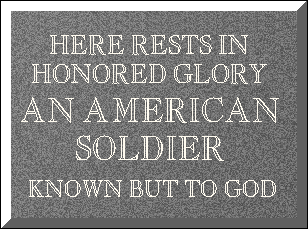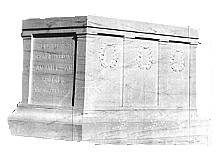|

They sent Sergeant Edward F. Younger into a musty little chapel in the French village of Chalons-sur-Marne on October 24, 1921, with a bouquet of flowers. In the dimly-lit room lay the remains of four American soldiers counted among the unidentified dead in the World War. The sergeant stood in the middle of the chapel for a moment and then walked resolutely to one of the coffins and laid the bouquet on it. That plain pine box was put on a battleship and sent to Washington to be entombed in Arlington National Cemetery, in the shadow of the peaceful Potomac Hills, with this inscription:
 President Harding put the Medal of Honor and the Distinguished Service Cross on the casket. A British dignitary added the Victoria Cross. Decorations from France, Italy, Rumania, Czechoslovakia and Poland followed. Then a general from Belgium emotionally ripped from his tunic the Medal of Valor pinned on him by his own King and put that down where the American soldier's chest should have been. Kirke L. Simpson of the Associated Press won the Pulitzer Prize for his story that day. It started this way, and it belongs in any history of the time:
There would be other unknown soldiers, all lower case. Looking back, that's where the pathos lay.

|

